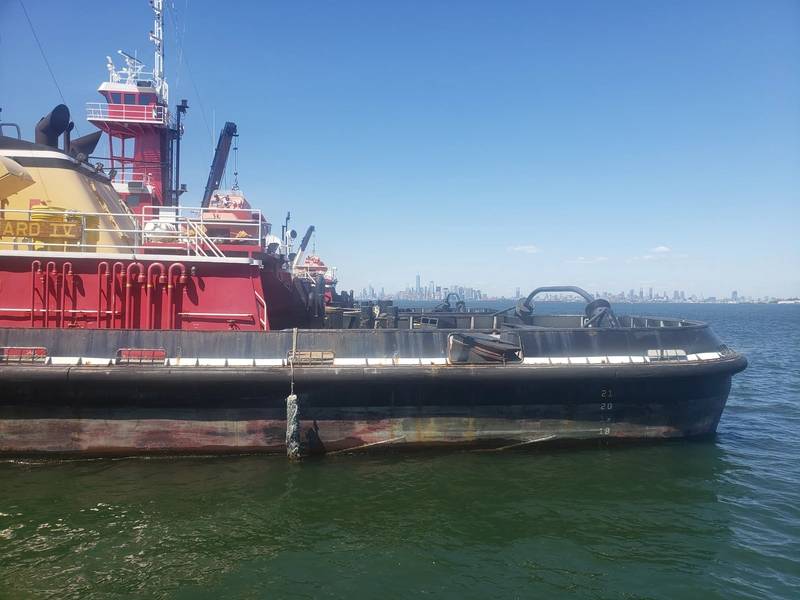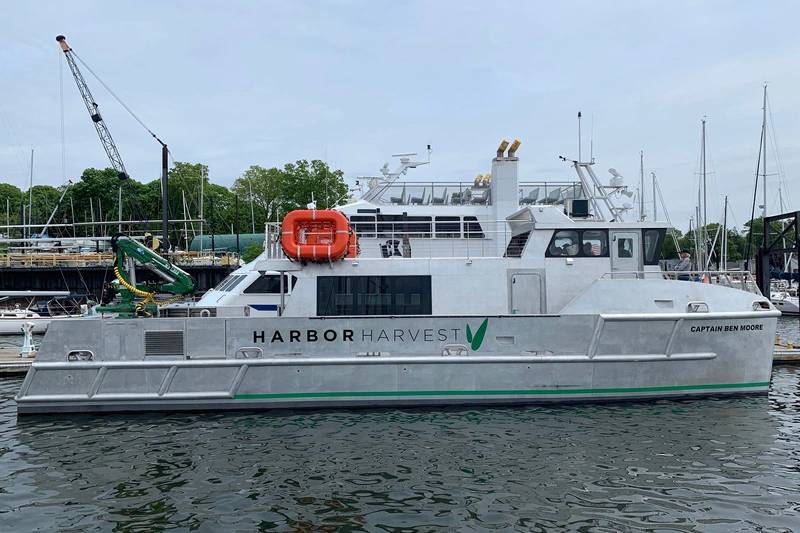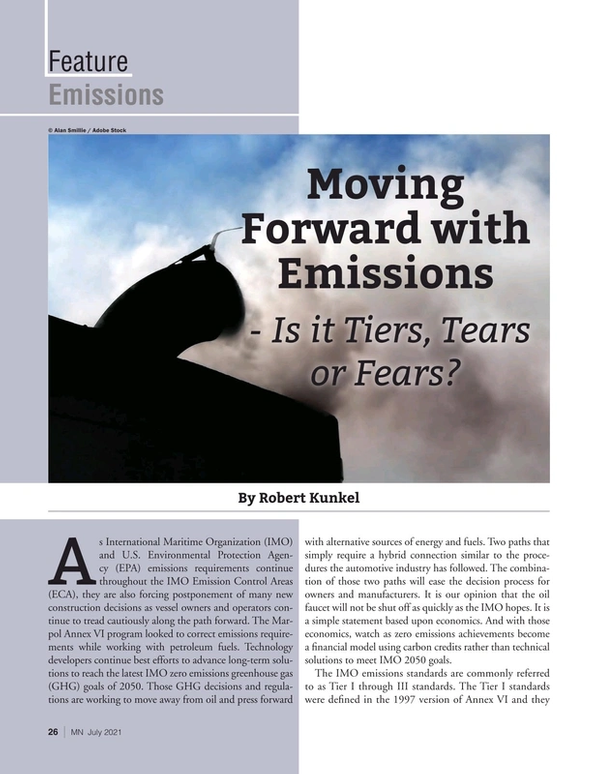
Moving Forward with Emissions - Is it Tiers, Tears or Fears?
As International Maritime Organization (IMO) and U.S. Environmental Protection Agency (EPA) emissions requirements continue throughout the IMO Emission Control Areas (ECA), they are also forcing postponement of many new construction decisions as vessel owners and operators continue to tread cautiously along the path forward. The Marpol Annex VI program looked to correct emissions requirements while working with petroleum fuels. Technology developers continue best efforts to advance long-term solutions to reach the latest IMO zero emissions greenhouse gas (GHG) goals of 2050. Those GHG decisions and regulations are working to move away from oil and press forward with alternative sources of energy and fuels. Two paths that simply require a hybrid connection similar to the procedures the automotive industry has followed. The combination of those two paths will ease the decision process for owners and manufacturers. It is our opinion that the oil faucet will not be shut off as quickly as the IMO hopes. It is a simple statement based upon economics. And with those economics, watch as zero emissions achievements become a financial model using carbon credits rather than technical solutions to meet IMO 2050 goals.
The IMO emissions standards are commonly referred to as Tier I through III standards. The Tier I standards were defined in the 1997 version of Annex VI and they are now ancient history in the discussion. The stricter Tier II/III standards were introduced by Annex VI amendments adopted in 2008—nearly 13 years ago. There’s been 13 years to address sulfur, nitrogen oxide and particulate matter in the air by regulation, and another 30 years to meet the IMO goals of 50% reduction of GHG by 2050.
IMO Tier II represented an approximate 20% reduction in NOx from Tier I and was applied to engines greater than 130 kW. The standard took effect in 2011 for all areas that adopted IMO Tier I (keep track through this article of the time that has passed to meet some of the simplest of requirements along with the new projection for the reduction of GHG to meet “zero emissions”).
Is the emissions goal post moving for most owners and manufacturers? You bet it is. A long-term goal has many moving parts.
The main changes to the original Marpol Annex VI have involved progressive reductions of SOx, NOx and particulate matter emissions globally. The introduction of ECAs was added worldwide to reduce those air pollutants to protect the coastal population areas. The latest tier (whether you are counting IMO or EPA designations) limits NOx emissions standard with enforcement from January 1, 2016 in ECAs as per the MEPC 66 meeting. Most do not understand that those requirements are only in the ECA. When returning to blue water, propulsion engines are not required to meet those NOx strict emissions standards. But to reduce GHG to zero and meet MEPC 77, engines will have to.
In many of the Far East yards the IMO 2016 requirements were circumvented by building keel blocks in inventory and having them certified as constructed prior to January of 2016. In turn offering them into new construction utilizing IMO Tier II propulsion engine standards as Tier III solutions were not available. We are in the new construction yards worldwide each day. Tier II engines and ships are being delivered well into 2021.
The regulatory loopholes were also applied within the domestic shipbuilding market. During the 2016 regulatory period there were no manufacturers developing IMO Tier III or EPA Tier 4 engines under 600Kw that could comply with the standards. In fact, larger propulsion engines utilized in the domestic workboat, tug and offshore operations only had EMD and General Electric to choose from to comply. That said, complying with propulsion did not relieve the domestic owners from meeting the requirements with generators and auxiliary engines. As a result, those newbuilds were restricted to only U.S. domestic operation. Operating in Canada or the Caribbean added a risk of losing that domestic “Tier” protection for those trading outside the zone. From a financial perspective or an investment opportunity, this created another hiccup in exit strategy should domestic markets fail.
 (Photo: Robert Kunkel)
(Photo: Robert Kunkel)
Owners have been forced to deal with the continuing regulation amendments when making decisions with assets that were financially modeled to trade anywhere between 20 and 40 years. The latest IMO revision to the EEDI calculation and EEXI amendments has also affected that decision process. In a recent construction supervision project in 2020 the owners delivered six chemical tankers that were a continuation of a design and delivery in 2016. Imagine their confusion when the 2016 vessels were determined to have a better energy rating than the 2020 builds because of changes to the EEDI and EEXI calculations. How these calculations will drift into smaller tug and offshore markets is yet to be seen.
Under Tier regulations engines are tested using distillate diesel fuels, even though residual heavy fuels are usually used in real life operation. Under GHG “zero emissions” projections we are now looking at methanol, liquefied natural gas (LNG), hydrogen, liquefied petroleum gas (LPG) and ammonia, all of which have different energy densities that affect consumption, tank space and Kw /HP requirements. The range is significant with marine gasoil (MGO) at an energy density of 35.9 to hydrogen at 8.5. Beyond those performance issues look to the cradle to grave environmental impact when processing and developing those new fuels when you are attempting to reach environmental goals in your company.
In our marine applications we have worked toward a hybrid combination of battery technology and fossil fuel very similar to how the automotive industry has developed. It will be difficult to move directly into full “marine EV” in the near future, and though we are supporters of alternative fuels and electric propulsion we understand the infrastructure requirements and costs involved. It is hard to look beyond the energy density of distillate low sulfur MGO after all the work the engine manufacturers have completed to meet the Tier requirements. A hybrid application allows full “EV” battery operation within the ECA or around coastal populations with zero emissions and combustion engine operation when extending the battery range. Energy storage is important when working toward those alternative fuels or a complete movement away from internal combustion engines. That hybrid application is in operation along the New England coast with our company First Harvest Navigation (a documentary on the project is available on YouTube).
The IMO goal of 50% reduction of GHG gases by 2050 requires all of these technical issues to be answered, built, tested and developed. Historically, regulation has never driven the marine markets. Private investment has been that leader and the investment path must have the ethics to take emissions reduction into the boardroom. Without that corporate drive you will see the application of carbon credits used to meet the 2050 goals.
 (Photo: Harbor Harvest Navigation)
(Photo: Harbor Harvest Navigation)
Read Moving Forward with Emissions - Is it Tiers, Tears or Fears? in Pdf, Flash or Html5 edition of July 2021 Marine News
Other stories from July 2021 issue
Content
- Interview: Ben Reed, Managing Director, HamiltonJet page: 12
- The Future of MASS is Drawing Closer page: 16
- AI is Pivotal for the Future of the Autonomous Shipping page: 17
- Marine Autonomy: The Future is Being Revealed page: 20
- Moving Forward with Emissions - Is it Tiers, Tears or Fears? page: 26
- Electronic Navigational Charts: An Update and Some Issues page: 30
- Tech File: X-Series Waterjets page: 36
- Tech File: Dynamic Protective Barrier page: 38


